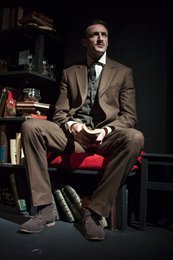In a New York Review of Books essay from last year entitled ‘What To Make Of Finnegans Wake?’, American writer Michael Chabon was surprisingly dismissive of A Portrait of the Artist as a Young Man. Describing it as “unlovable” and a “stamp in the passport’, Chabon claimed Portrait “fouls its rotors in a dense kelpy snarl of cathected horniness, late-Victorian aesthetics, and the Jesuitical cleverness that, even in Ulysses, wearies the most true-hearted lover of Joyce.” Whatever your feelings about Joyce’s first novel – mine tend to be of sepia-toned nostalgia for pre-exile, pre-eyepatch Joyce, as well as for my late teen years when I first picked up the book – it is clear that in recent years, in a critical sense, Portrait has been obscured, lost somewhere between the understated perfection of Dubliners and the maddening ambition of Ulysses and Finnegans Wake.
 And so Tony Chesterman’s adaptation of Portrait arrives to us at the height of Bloom season. The New Theatre is no stranger to Joyce adaptations, having staged Patrick Fitzgerald’s enjoyable Gibraltar after the works of Joyce passed out of copyright in January 2012. For the liver-engorged Joycean, for the Joyce tourist looking for a kindly port before embarking on choppier waters, or for those looking for another experience of the novel, there is much value in this production. Rather than cram the entire novel into two acts, Chesterman and director Jimmy Fay instead probe deeper into the novel’s duelling, intermeshed themes: the Church’s psychic stranglehold over every dimension of Irish life and the struggle of a young Irish artist to rise above, and ultimately, away from that.
And so Tony Chesterman’s adaptation of Portrait arrives to us at the height of Bloom season. The New Theatre is no stranger to Joyce adaptations, having staged Patrick Fitzgerald’s enjoyable Gibraltar after the works of Joyce passed out of copyright in January 2012. For the liver-engorged Joycean, for the Joyce tourist looking for a kindly port before embarking on choppier waters, or for those looking for another experience of the novel, there is much value in this production. Rather than cram the entire novel into two acts, Chesterman and director Jimmy Fay instead probe deeper into the novel’s duelling, intermeshed themes: the Church’s psychic stranglehold over every dimension of Irish life and the struggle of a young Irish artist to rise above, and ultimately, away from that.
Five actors (and a skeleton) embody the novel’s many characters (though Joyce’s mother, who looms over all of his enquiries, is nowhere to be seen). The casting is particularly on song: Dedalus, the young man in question, is played by a young woman (Lauren Farrell) who brings both an incredible physical agility and an inquisitive gentleness to the role of one of Ireland’s best-known artists. Charlie Hughes, Patrick O’Donnell and Katie O’Kelly then inhabit the various warring spirits of the novel – the family, clergy and prostitutes – while Marcus Lamb narrates as Cranly, Joyce’s real-life confidante J.F. Byrne, who was given the slightly posh surname by the author in the novel and holds, above all, an awe for Joyce’s artistic convictions.
.jpg.aspx) The power of Chesterman’s loving adaptation is in the first act set pieces that Fay conjures. While chunks of Joyce’s writing have had to be left out of the text, Father Arnall’s sermon mapping out the physical dimensions and eternal torments of Hell – issued powerfully on rotation by O’Donnell, O’Kelly and especially Hughes against a backdrop of blackness – exists seemingly in full, and even to an audience in an increasingly godless Ireland, is utterly, utterly terrifying. Dedalus’ confessions of sin are no less fear-rendering, thanks in part to the whip-wielding O’Kelly, who as a sort of dominatrix demon, seems to deliver a genuine flogging to the repentant sinner.
The power of Chesterman’s loving adaptation is in the first act set pieces that Fay conjures. While chunks of Joyce’s writing have had to be left out of the text, Father Arnall’s sermon mapping out the physical dimensions and eternal torments of Hell – issued powerfully on rotation by O’Donnell, O’Kelly and especially Hughes against a backdrop of blackness – exists seemingly in full, and even to an audience in an increasingly godless Ireland, is utterly, utterly terrifying. Dedalus’ confessions of sin are no less fear-rendering, thanks in part to the whip-wielding O’Kelly, who as a sort of dominatrix demon, seems to deliver a genuine flogging to the repentant sinner.
Orla Reynolds’ set, decorated with a gramophone, a Parnell portrait and some other Edwardian detritus, is sparse but provides the space for two of Dedalus’ most pressing pursuits in the novel: knowledge and temptation.
If the continuing mystery of Ulysses is that unencountered nugget – a winner at Ascot that year or a mention of a street in Stoneybatter you once lived on – amid the flotsam and jetsam of Dublinia a hundred years ago, Portrait endures because Joyce provided future readers with his own creation myth. Perhaps Chesterman and Fay’s most intriguing achievement here – especially during Cranly’s second act inquisition of Dedalus about his artistic ambitions – is to give us a young Dedalus who is neither haughty nor solipsistic, just curious and driven. Perhaps it took a young woman to provide a glimpse into that side of Joyce.
Donald Mahoney is a writer and journalist